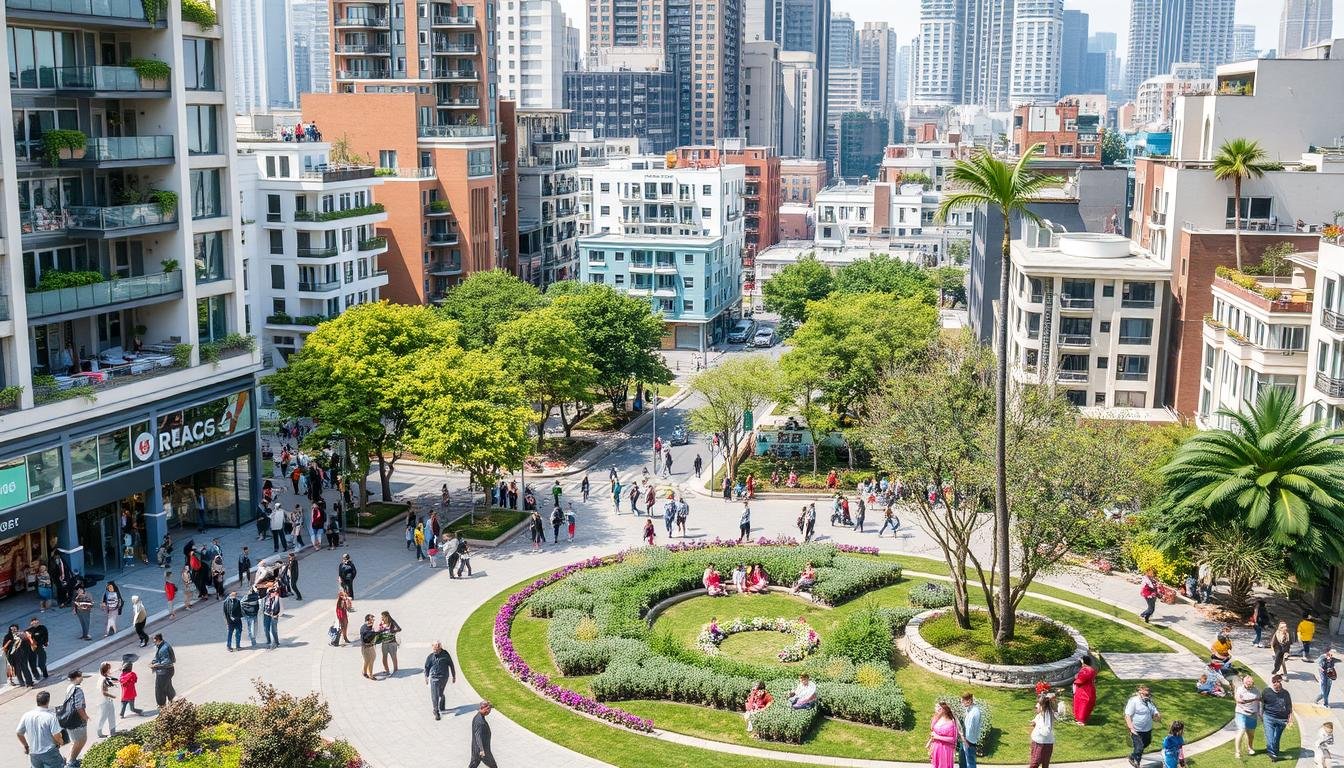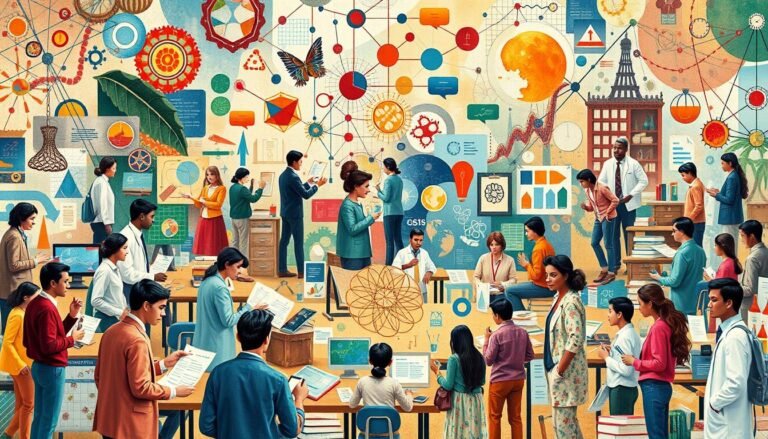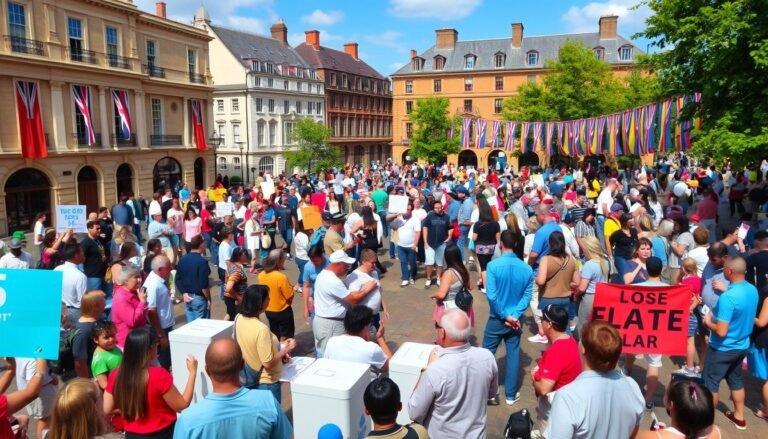The Role of Sociology in Urban Planning
Can cities truly thrive without knowing the people who live there? This question is key to urban sociology. It’s a field vital for shaping our cities as they grow and change.
Urban sociology looks into the social structures and processes of city life. It sees how people act in cities and how cities shape their behavior. Sociologists in places like Buenos Aires and Detroit are finding insights that help with city planning and policy.
Consider Jacob Lederman, an urban sociologist. He started studying Buenos Aires in 2012, comparing it to cities like Detroit. His book, “Chasing World-Class Urbanism,” shows how Buenos Aires aimed for a “world-class” status and its effects on the city.
His knowledge of Spanish let him deeply understand the city’s planning. This gave him a new view on urban challenges.
Urban sociology does more than just research. It’s key in solving big issues like poverty, affordable housing, and education. By looking into poverty and housing policies, sociologists give important data for city planning. Their work aims to make cities efficient, fair, and good for everyone.
Key Takeaways
- Urban sociology studies social structures and processes in cities
- Sociological perspectives are crucial for effective urban planning
- Research in cities like Buenos Aires offers insights for global urban development
- Urban sociology addresses issues such as poverty, housing, and education
- The field helps create more equitable and livable urban spaces
Understanding Urban Sociology: A Foundation for Planning
Urban sociology is key to planning cities well. It shows how people live and interact in cities. This field started when cities grew fast during the Industrial Revolution, bringing new problems.
Defining Urban Sociology
Urban sociology looks at city life and its effects on people. It examines how cities change human behavior and social groups. It focuses on poverty, racial segregation, migration, and how neighborhoods change. These findings help make cities better.
Historical Development
The Chicago School of Sociology started in the 1910s and lasted until the 1940s. They studied Chicago’s fast growth and how it made social problems worse. Their work used detailed field studies to get to know city life.
Key Theories in Urban Sociology
Urban sociologists use theories to explain city life. The “Community Lost” theory says cities break social bonds. But “Community Saved” believes people in cities form strong local connections. “Community Liberated” suggests city folks have diverse social networks.
- Statistical analysis of urban poverty rates
- Ethnographic studies of neighborhood dynamics
- Research on how public spaces affect social interaction
These theories and studies help planners make cities better. By knowing how people use and interact in cities, planners can make cities more livable and inclusive.
The Intersection of Sociology and Urban Planning
Urban planning is more than just building structures. It combines social and economic elements to make cities livable. Sociologists are crucial in this effort. They offer deep insights into how people behave and social patterns.
Sociologists examine how people interact in cities. They study segregation, culture, and social order. This knowledge helps planners design cities for everyone. It’s not just about buildings and roads. It’s about understanding the people who live there.
Urban planners use sociology to address social inequalities. They create spaces that are fair and inclusive. This leads to sustainable cities and supports neighborhood improvement.
“Cities are not just brick and mortar. They are living, breathing entities shaped by the people who inhabit them.”
Sociologists help planners see the whole picture. They look at ethnic, religious, and cultural factors. This approach leads to cities that are both practical and beautiful. It’s a mix of science and art, making cities that truly serve their people.
| Sociological Aspect | Impact on Urban Planning |
|---|---|
| Community Dynamics | Informs public space design |
| Cultural Diversity | Shapes neighborhood planning |
| Social Inequalities | Drives equitable development |
| Human Behavior | Influences transportation planning |
Sociological Perspectives in Urban Development
Urban development changes our cities and lives. Sociologists study how social structure affects urban areas. They look at how community and culture shape city planning.
Social Structure and Urban Spaces
Cities mirror the social setup of their people. The concentric zone model shows how cities grow in rings. Each ring has different social groups.
For example, immigrant communities often live near city centers. Wealthier people tend to live in outer rings.
Community Dynamics in City Planning
Getting community input is crucial in city planning. Participatory planning lets people shape their neighborhoods. But, not all voices are heard the same way.
NIMBY (Not In My Backyard) movements show how some groups have more power. These often happen in wealthy areas opposing changes that might affect them.
Cultural Factors Influencing Urban Design
Culture greatly affects urban design. In the U.S., cities are built for cars. European cities focus more on public transit and walking.
These choices reflect cultural values. Urban residents tend to have more open views on social issues than rural folks. This impacts how cities are planned and used.
Understanding these sociological perspectives helps create better cities for everyone. It ensures urban development meets the needs of diverse communities. By balancing social structure, community dynamics, and cultural factors, we can build more inclusive and livable urban spaces.
Addressing Social Inequalities Through Urban Planning
Urban planning is key to fighting social inequalities. In India, over 31.5% of people live in cities, and more than 40% lack basic needs. This shows the need for strong urban planning to tackle poverty and ensure social fairness.
Affordable housing is a big challenge. Around the world, 828 million people live in slums, facing poverty and joblessness. In India, fast city growth has led to more people living in bad housing, causing poor health and sanitation.
Education and health are crucial for city life. Education can help people move up in life but is weakening, making inequality worse. Having equal access to education is important for city well-being.
Education and self-sufficiency are connected. They help women get medical care and care for their families.
Zoning laws affect city equality too. In the US, most areas are zoned for low-density homes, making it hard for those without big budgets to find homes. This limits housing, raises prices, and makes income differences worse.
| Factor | Impact on Social Equity |
|---|---|
| Affordable Housing | Reduces homelessness and improves living conditions |
| Education Access | Enhances social mobility and reduces inequality |
| Zoning Reforms | Increases housing supply and promotes diverse communities |
Urban planners need to make policies that help everyone. They should focus on affordable homes, better education access, and changing zoning laws. This way, they can make cities fairer and lessen social gaps.
The Role of Sociology in Urban Planning
Urban sociology is key in shaping cities. It helps planners grasp social realities and make smart choices. This field adds important insights to policy-making and city growth.
Analyzing Social Realities in Urban Areas
Sociologists deeply examine city life. They study how people interact and live in cities. With 55% of the world’s people living in cities, this work is crucial. They use methods like photovoice to gather data. Photovoice lets residents share their stories through photos.
Providing Insights for Policy-Making
Urban sociologists give vital insights for city policies. They look into issues like poverty, housing, and safety. Their research shapes programs that really work. For instance, they study how affordable housing affects poverty.
This info helps policy-makers make better choices.
Integrating Physical and Social Factors in Planning
Good urban planning looks at both physical and social sides. Sociologists blend these elements together. They see how street design affects safety and community life. Their work ensures cities meet people’s needs. This leads to more livable cities.
Graduates in urban sociology bring special skills to planning jobs. They know social patterns and can make sense of complex data. This knowledge is useful in community development, transportation planning, and environmental projects. By using social analysis, they help make cities better for everyone.
Urban Infrastructure and Sociological Considerations
Urban infrastructure greatly affects how people act and connect in communities. It includes everything from how cities are laid out to the services available to the public. The New Urbanism movement, starting in the 1980s, aims to build neighborhoods that are easy to walk through. It encourages green living and offers a variety of homes.
Jane Jacobs wrote about the need for cities designed with people in mind in her 1961 book. This idea became popular in the 1980s. Now, city planners and architects work to blend human life into city plans. They focus on making cities sustainable and places where people can thrive.
Transportation planning is vital for cities. Some suggest using self-driving cars to solve traffic problems. Yet, others believe in building smaller, walkable cities. Kent Larson, a researcher at MIT Media Lab, agrees with the latter. He thinks cities should be designed for people, not just cars.
| Urban Planning Focus | Description |
|---|---|
| Strategic Urban Planning | Setting high-level goals for transportation, community spaces, and quality of life |
| Land-Use Planning | Influencing land use through legislation and policies |
| Urban Revitalization | Improving declining areas through infrastructure development and public space enhancement |
Public services are key to a city’s infrastructure. Good planning makes sure everyone has access to what they need. This includes making cities sustainable, fighting pollution, and protecting nature.
As cities grow, experts study how their design affects people and the economy. Their findings help make cities better for everyone. They aim for places that are fair, efficient, and great for living.
Public Spaces and Community Engagement: A Sociological Approach
Urban planners and sociologists work together to make public spaces vibrant and inclusive. They focus on getting the community involved and planning together. This way, cities become places that really serve their people.
Designing Inclusive Public Spaces
Inclusive public spaces help bring people together. Studies show that green spaces in cities can make people feel better mentally. Being attached to a neighborhood also helps, especially if people work together and garden.
Fostering Community Participation in Urban Planning
Getting people involved in planning is key to making spaces that meet their needs. Research shows that strong communities are good for public health. By letting residents help plan, cities can make areas more lively and build stronger bonds among people.
Sociological Methods for Community Input
Sociologists use different ways to hear from the community. These include:
- Photovoice: People share their views through photos
- Focus groups: Small groups talk about city issues
- Surveys: People share what they like and need
These methods help planners see how people use and enjoy city spaces. This leads to cities that are better for everyone.
By using sociological insights in planning, cities can make public areas that bring people together. This makes life better for everyone living there.
Sustainable Cities: Merging Sociology and Urban Planning
Cities are changing fast to tackle 21st-century challenges. With 55% of people living in cities now, and 68% by 2050, making cities green is key. Social ecology helps create cities that welcome everyone, are safe, and can bounce back from tough times.
Studies focus on making cities better places to live, in line with the United Nations’ Sustainable Development Goal 11. They look at how cities can be more inclusive, fair, and avoid the negative effects of change. For example, arts programs help young people who are not in school or working feel part of the community.
Climate-neutral and smart cities lead the way in making cities sustainable. They focus on fairness and using tech to meet goals. Adding smart homes to cities can also make them better for the planet and people.
- Cities account for 70% of global carbon emissions
- Urban waste generation is expected to increase by 70% by 2050
- Cross-sector actions are vital for achieving urban sustainability
Combining sociology and urban planning is key to making cities sustainable. By thinking about people and buildings together, planners can make cities better for everyone. This way, cities can be greener and support happy, fair communities.
Conclusion: The Future of Sociology in Urban Planning
The future of urban sociology careers is promising as cities tackle complex challenges. Urban planners and sociologists will work together to shape cities. They aim to make cities livable, fair, and green.
Sociological research is crucial in solving urban problems. It brings insights on everything from smart city tech to improving slums. In places like Asia, Africa, and Latin America, new urban projects are leading the way to better cities.
As cities expand, social gaps grow. Urban sociology helps close these gaps. It guides planners to make cities for everyone. With methods like community input and data analysis, sociologists build unity in cities.
The future of urban sociology and planning is clear. It’s about creating cities that are more than just buildings and roads. By combining social knowledge with urban design, we can make cities that truly benefit their people.
Source Links
- Sociology professor explores the impact of urban planning in new book
- City Planning – Urban Sociology – iResearchNet
- No title found
- Practical Applications of Urban Sociology in Planning & Social Issues
- Urban sociology
- URBAN SOCIOLOGY THEORIES
- New research center studies interconnections between urbanism and the environment, with a focus on lessons from the Santa Cruz region
- Faranak Miraftab | Department of Urban & Regional Planning
- Theoretical Perspectives on Urbanization | Introduction to Sociology
- 14.2 Sociological Perspectives on Urbanization
- Urbanization
- IJRTI
- Zoning, Land Use, and the Reproduction of Urban Inequality
- Diverse Approaches to Understanding Urban Sociology • Sociology Institute
- 2024 Urban Planning with a Sociology Degree: Career Paths » Archova Visuals
- Urban sociology – Sociological Reasoning
- 7 Key Urban Planning Concepts for Sustainable City Development
- The Relationship between Social Cohesion and Urban Green Space: An Avenue for Health Promotion
- Understanding the Relationship between Urban Public Space and Social Cohesion: A Systematic Review – International Journal of Community Well-Being
- The sociology of urban public spaces
- Editorial: Towards 2030: Sustainable Development Goal 11: sustainable cities and communities. A sociological perspective
- Transforming cities for sustainability: A health perspective
- The Evolution of Urban Sociology: From Early Studies to Modern Concepts • Sociology Institute
- Interdisciplinary Perspectives in Urban Sociology • Sociology Institute
- Conclusion







